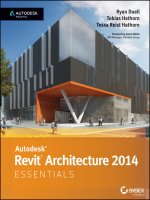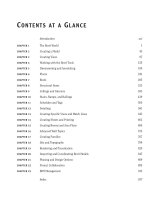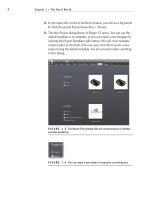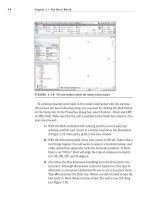Mastering Autodesk Revit MEP 2014
Bạn đang xem bản rút gọn của tài liệu. Xem và tải ngay bản đầy đủ của tài liệu tại đây (38.89 MB, 746 trang )
Mastering
Autodesk
®
Revit
®
MEP 2014
Mastering
Autodesk
®
Revit
®
MEP 2014
Don Bokmiller
Simon Whitbread
Plamen Hristov
Senior Acquisitions Editor: Willem Knibbe
Development Editor: Dick Margulis
Technical Editor: Steve Stafford
Production Editor: Eric Charbonneau
Copy Editor: Sharon Wilkey
Editorial Manager: Pete Gaughan
Production Manager: Tim Tate
Vice President and Executive Group Publisher: Richard Swadley
Vice President and Publisher: Neil Edde
Book Designers: Maureen Forys and Judy Fung
Compositor: Craig Woods, Happenstance Type-O-Rama
Proofreader: James Saturnio, Word One New York
Indexer: Jack Lewis
Project Coordinator, Cover: Katherine Crocker
Cover Designer: Ryan Sneed
Cover Image: iStockphoto.com / Richard Goerg
Copyright © 2013 by John Wiley & Sons, Inc., Indianapolis, Indiana
Published simultaneously in Canada
ISBN: 978-1-118-604199-9
ISBN: 978-1-118-74137-5 (ebk.)
ISBN: 978-1-118-75817-5 (ebk.)
No part of this publication may be reproduced, stored in a retrieval system or transmitted in any form or by any means, electronic,
mechanical, photocopying, recording, scanning or otherwise, except as permitted under Sections 107 or 108 of the 1976 United States
Copyright Act, without either the prior written permission of the Publisher, or authorization through payment of the appropriate per-
copy fee to the Copyright Clearance Center, 222 Rosewood Drive, Danvers, MA 01923, (978) 750-8400, fax (978) 646-8600. Requests to
the Publisher for permission should be addressed to the Permissions Department, John Wiley & Sons, Inc., 111 River Street, Hoboken,
NJ 07030, (201) 748-6011, fax (201) 748-6008, or online at www.wiley.com/go/permissions.
Limit of Liability/Disclaimer of Warranty: The publisher and the author make no representations or warranties with respect to
the accuracy or completeness of the contents of this work and specically disclaim all warranties, including without limitation
warranties of tness for a particular purpose. No warranty may be created or extended by sales or promotional materials. The
advice and strategies contained herein may not be suitable for every situation. This work is sold with the understanding that the
publisher is not engaged in rendering legal, accounting, or other professional services. If professional assistance is required,
the services of a competent professional person should be sought. Neither the publisher nor the author shall be liable for dam-
ages arising herefrom. The fact that an organization or Web site is referred to in this work as a citation and/or a potential source
of further information does not mean that the author or the publisher endorses the information the organization or Web site
may provide or recommendations it may make. Further, readers should be aware that Internet Web sites listed in this work may
have changed or disappeared between when this work was written and when it is read.
For general information on our other products and services or to obtain technical support, please contact our Customer Care
Department within the U.S. at (877) 762-2974, outside the U.S. at (317) 572-3993 or fax (317) 572-4002.
Wiley publishes in a variety of print and electronic formats and by print-on-demand. Some material included with standard print
versions of this book may not be included in e-books or in print-on-demand. If this book refers to media such as a CD or DVD that
is not included in the version you purchased, you may download this material at . For more
information about Wiley products, visit www.wiley.com.
Library of Congress Control Number: 2013935675
TRADEMARKS: Wiley, the Wiley logo, and the Sybex logo are trademarks or registered trademarks of John Wiley & Sons, Inc. and/or
its afliates, in the United States and other countries, and may not be used without written permission. Autodesk and Revit are regis-
tered trademarks of Autodesk, Inc. All other trademarks are the property of their respective owners. John Wiley & Sons, Inc. is
not associated with any product or vendor mentioned in this book.
10 9 8 7 6 5 4 3 2 1
Dear Reader,
Thank you for choosing Mastering Autodesk Revit MEP 2014. This book is part of a family of
premium-quality Sybex books, all of which are written by outstanding authors who combine
practical experience with a gift for teaching.
Sybex was founded in 1976. More than 30 years later, we’re still committed to producing consis-
tently exceptional books. With each of our titles, we’re working hard to set a new standard for
the industry. From the paper we print on to the authors we work with, our goal is to bring you
the best books available.
I hope you see all that reected in these pages. I’d be very interested to hear your comments
and get your feedback on how we’re doing. Feel free to let me know what you think about this
or any other Sybex book by sending me an email at If you think you’ve found
a technical error in this book, please visit . Customer feedback is
critical to our efforts at Sybex.
Best regards,
Neil Edde
Vice President and Publisher
Sybex, an Imprint of Wiley
To my wife, family, friends, and coworkers, with
much gratitude.
—Don Bokmiller
To my wife and daughter for all their support, all the
time, thank you.
—Simon Whitbread
To my family, friends, and coworkers, thank you all.
—Plamen Hristov
Acknowledgments
This is my favorite part of the book to write, where I get to thank my darling wife, Shelley. Thanks
also to my family for your kindness and encouragement.
I have had the great opportunity to work with many wonderful people who have inuenced
my career and provided wisdom, guidance, and friendship. I want to thank my friends and col-
leagues at Clark Nexsen, where I have been given the opportunity to grow and learn in a terric
working environment, which I could never take for granted. Thanks Johan, Noah, Jeff, Willie, Tim,
Creighton, Cheryl, and Larry. Thank you to all the great people I’ve met at the Revit Technology
Conferences, and those I’ve had the opportunity to work with at Autodesk University, especially
Joel and Jarrod. Peer networking is such a great way to learn and develop new ideas.
I cannot bypass the opportunity to thank all the incredible people at Sybex. Thank you,
Willem, for once again keeping things moving. Thank you, Dick, Eric, and Sharon, for being
such great editors. I’m sure there are many others who have worked hard to bring this book
together. Thank you, all!
Thank you, Simon. I truly enjoy working with you on these books. Thanks also for your friend-
ship. Plamen, thank you so much for all that you bring to the table. Thank you, Steve, for doing the
dirty work of the technical edit. Your input has proven invaluable. It has been my pleasure to work
with you all.
—Don Bokmiller
To my wife, Carole, thank you for your continued support over the past year while I have been
working on this and other projects; it doesn’t go anywhere near the thanks due for all your hard
work and patience during the time I have been either working away from home, or writing late
into the night. Your support over the years has helped me achieve so much—what else can I say
but thank you and I love you. Thanks also to my daughter, Jess, a beautiful, hardworking, caring
person who now knows a man who will forever be known as Disco Bob.
Professionally, thank you to Jasmax architects; their early vision of a collaborative environment
meant that I (and they) had an early introduction to Revit. For his encouragement, thank you also
goes to Shane Morris, CTO with one of the world’s largest Autodesk resellers, A2K Technologies,
for whom I provide Revit MEP consulting, teaching and implementation services. Their extended
team is the best to work with.
Thank you also to everyone at Sybex who helped to get this edition moving. It seems unfair
to single out any one person; sufce it to say that without you, there would be no book.
Finally, a special thanks to Don Bokmiller. What? Again? You wanted my help…again? It’s
been a pleasure. I think we have a really strong team; let’s keep it going!
—Simon Whitbread
To my mother, Krisi, and my dad, Marin, thank you for raising me and, more important, for the
encouragement, faith, and love you surrounded me with while guiding me on this journey to
the man I have become. I can never thank you enough!
Many thanks to all the people whom I have learned so much from and without a doubt have
inuenced my personal and professional life—Saeid Berenjian, Shawn Zirbes, Bob Palioca,
David Haynes, Glynnis Patterson, Dennis Nunes, Mark Reid, Bryan Johnson, and Lowell
Shields. Thanks to my friends Stephanie, Suzie, Jessica, Ethan, and Krinchev.
I also want to thank all my colleagues at Capital Engineering Consultants, Inc. for the great
opportunity to be part of an amazing team.
And nally, thanks to Don, Simon, and the entire Sybex team for giving me the opportunity
to be part of something I will never forget.
—Plamen Hristov
About the Authors
Don Bokmiller is a CAD/BIM specialist at Clark Nexsen, an architec-
ture and engineering rm in Norfolk, Virginia. He has worked in the
AE design industry since 1996, when he started out as a CAD techni-
cian in the electrical department. As the company grew, he eventually
became one of a few CAD managers, while also participating as an
electrical designer on several projects. When Revit Systems came along,
he participated in the Autodesk Beta program and has continued to do
so for each release. His current position is to optimize the company’s use of Revit MEP. He cur-
rently works in a team under the direction of the IT department director, tying the software
user experience directly to the software, hardware, and network administrators. Don has also
worked as an application specialist, supporting clients of various sizes and company structures
on their use of Revit MEP. He has taught classes and given presentations to local engineering
organizations. Don is an Autodesk User Group International (AUGI) member and has pre-
sented at Autodesk University and the Revit Technology Conference USA.
Simon Whitbread, Revit and CAD implementation specialist, started
using Revit at release 5.1. He has over 30 years of experience in the build-
ing services and architectural industries. Since the early 1990s, he has
been involved in developing and managing CAD and IT systems. He
moved to New Zealand in 2002, where he led the implementation of
Revit Architecture at Jasmax, one of New Zealand’s leading architectural
practices. More recently he has been providing implementation, support,
and training services for AutoCAD and the Revit suite of programs to
companies in Australia, Dubai, Indonesia, New Zealand, Singapore, the
United States, and the United Kingdom. Simon enjoys spending time with his family, is a frequent
speaker at Autodesk University and Revit Technology Conference (RTC) events, is a member of
AUGI, is on Twitter, and is part of the Australasian organizing committee for the RTC.
Plamen Hristov is the director of design technology at Capital Engineering
Consultants, Inc., where he is leading the implementation of building infor-
mation modeling (BIM).
Plamen has also worked as an application specialist, actively develop-
ing Autodesk Revit implementation strategies, techniques, and proce-
dures for architectural and MEP companies. He has been establishing
and updating company standards and best practices, as well as assisting
project teams with pilot projects, implementations, on-site project consult-
ing, custom content creation, and training. Plamen is an Implementation
Certied Expert (ICE), and he has presented various BIM topics at Autodesk University, the Revit
Technology Conference, Ecobuild America, and Revit user groups.
Contents at a Glance
Introduction xxv
Part 1 General Project Setup 1
3
31
83
109
147
167
201
Part 2 Autodesk Revit MEP for Mechanical Design 237
239
2 69
293
323
Part 3 Autodesk Revit MEP for Electrical Design 345
3 47
371
407
Part 4 Autodesk Revit MEP for Plumbing 437
439
XII
|
CONTENTS AT A GLANCE
461
Part 5 Managing Content in Autodesk Revit MEP 475
477
509
533
565
593
615
639
Appendix e Bottom Line 665
Index 689
Contents
Introduction xxv
1
3
The Ribbon 3
Using Tabs 4
Using Contextual Tabs 10
Using Family Editor Tabs 10
Customizing the Ribbon 12
Quick Access Toolbar 13
User Interface Features 14
Options Bar 14
Properties Palette 15
View Control Bar 17
Status Bar 21
Info Center 21
Exchange Apps 22
User Interface Control 22
Menus and Settings 23
Keyboard Shortcuts 25
Graphics 27
Context Menus 28
The Bottom Line 30
31
Understanding Templates 32
Understanding the Project Browser Organization 32
Determining Which Views Are Grouped Together 33
Sorting Views within Groups 34
Determining the Number and Types of Views Needed 35
Setting the Number of Levels 36
Working with Plan Types 37
Creating a Working View 37
Choosing Display Settings for Views 37
Visibility Settings for Template Views 39
Visibility Settings Shortcut: View Templates 45
Schedule Views 46
Establishing Project Settings 48
Object Styles 48
Drafting Line Settings 49
XIV
|
CONTENTS
Export Settings 54
Annotation Styles . . . . . . . . . . . . . . . . . . . . . . . . . . . . . . . . . . . . . . . . . . . . . . . . . . . . . . . . 58
Project Units 62
Project Phases 63
Dening Preloaded Content and Its Behavior 66
Annotation Families 66
Component Families 68
System Families 71
MEP Settings 74
Creating Sheet Standards . . . . . . . . . . . . . . . . . . . . . . . . . . . . . . . . . . . . . . . . . . . . . . . . . . . . 77
Titleblocks 77
Sheet Organization 77
Preset Sheets (Not Placeholder Sheets) 78
The Bottom Line 81
83
Understanding Central Files 83
Creating a Central File 84
Creating a New Workset 88
Working with Local Files 91
Creating a Local File 91
Synchronizing a Local File with the Central File 93
Managing and Using the Power of Worksets 96
Taking Ownership of Worksets 97
Working with Model Elements and Their Worksets 98
Controlling Visibility and Worksets 102
Enhancing Communication 106
The Bottom Line 108
109
Preparing Your Files for Sharing 109
Working with Linked Revit Files 112
Linking Revit Files 112
Using Shared Coordinates 115
Managing Revit Links 117
Controlling Visibility of Revit Links 119
Coordinating Elements within Shared Models 124
Monitoring Elements 125
Responding to Change Alerts 129
Reconciling Hosting 130
Maintaining Project Coordination 132
Working with Files from Other Applications 13 3
Linking CAD Files 133
Exporting Your Revit File to a CAD Format 136
Using Image Files in a Revit Project 138
Setting Options for Quality Control 141
CONTENTS
|
XV
Using Autodesk Revit Server 144
Using Cloud-Based Solutions 144
The Bottom Line 145
and 3D Data 147
2D Data Types 148
MicroStation 2D DGN 148
DX F 149
2D Data for Standard Details 149
2D Data for Plans, Sections, and Elevations 151
3D Data Types 158
Revit Project File 158
Revit Family File 161
ADSK 161
IFC 162
AutoCAD DWG 163
SketchUp 163
Other File Formats 16 3
Point Clouds 164
The Bottom Line 165
167
Understanding Parameter Basics 168
Choosing the Correct Parameter 16 8
Naming Parameters 168
Using Type Parameters 169
Using Instance Parameters 171
Setting Parameter Discipline, Type, and Grouping 172
Using Parameters in Families 175
Dimensional Parameters Lock Function 176
Parameter Types 176
Type Catalogs 178
Formulas 181
System Parameters 182
Lookup Tables 183
Using Shared Parameters 184
Using Parameters in Projects 189
Project Parameters 189
Parameters in Schedules 19 1
Creating and Using Parameters in Families and Schedules 193
View and Sheet Parameters 195
Working with Formulas 197
Sample Conditional Statements 198
Rounding 198
The Bottom Line 199
XVI
|
CONTENTS
201
Dening Schedules 201
The Fields Tab 203
The Filter Tab 206
The Sorting/Grouping Tab 208
The Formatting Tab 209
The Appearance Tab 213
Editing a Schedule 213
Scheduling Component and System Family Data 217
Mechanical Equipment Schedules 217
Lighting Fixture Schedules 218
System Family Schedules 220
Model Component Schedules 223
Using Schedules for Design and Analysis 225
Schedule Keys 226
Panel Schedules 229
Using Schedules for Project Management . . . . . . . . . . . . . . . . . . . . . . . . . . . . . . . . . . . . . 231
Sheet List 232
View List 233
Note Block 234
The Bottom Line 236
237
239
Modeling Spaces for Building Load Analysis 239
Creating Spaces 240
Placing Spaces 241
Creating a Space Properties Schedule 241
Modifying Space Properties 242
Creating Zones 245
Setting Building Construction Options 247
Performing Heating and Cooling Load Analysis 249
Load Analysis 2 51
Weather Data 252
Outdoor Air Inltration 253
Sliver Spaces 253
Details 254
Heating and Cooling Loads Report 256
Performing Conceptual Energy Analysis on Your Building 259
Setting Up the Model 259
Keeping It Simple 262
Performing Energy Simulation 263
Analyzing Duct and Pipe System Pressure 264
Exporting gbXML Data to Load-Simulating Software 264
The Bottom Line 267
CONTENTS
|
XVII
269
Managing Systems 269
Why Are Systems Important? 269
Mechanical Settings 271
System Browser 272
Setting Up Air Systems 273
Understanding Parameters 274
Creating Mechanical Systems 277
Setting Up Piping Systems 281
Understanding Parameters 282
Creating Pipe Systems 283
Creating Fire-Protection Systems 286
Setting Display Properties of Systems 286
Understanding Child and Parent Relationships in Revit Systems 287
Using System Filters 288
The Bottom Line 292
293
Air Distribution Components 293
Mechanical Equipment Components 295
Air Conditioning/Handling Units 295
VAV B oxes 296
Ductwork 297
Duct Types and Routing 301
Creating New Duct Types 302
Using Automatic Duct Routing 302
Using Manual Duct Routing 307
Duct Sizing 312
Choosing a Duct Sizing Method 314
Using the Duct Routing Tools 319
The Bottom Line 322
323
Mechanical Pipe Settings 32 3
Creating Piping Systems 324
Creating Pipe Types 326
Dening Fitting Angles 327
Selecting Fittings for Routing Preferences 329
Choosing Pipe Materials and Sizes 329
Adjusting the Pipe Sizing Table 329
Using the Fluids Table 330
Pipe Routing Options 331
Automatic Pipe Routing 331
Manual Pipe Routing 332
Pipe Fittings 338
Using Pipe Fitting Controls 339
Placing Valves 339
XVIII
|
CONTENTS
Adding Piping Insulation 340
Dening Systems Visibility through Filters 340
The Bottom Line 343
345
347
Efcient Lighting Design 347
Spaces and Lighting 347
The Reected Ceiling Plan 350
Lighting Worksets 351
Lighting Analysis 352
Hosting Options for Lighting Fixtures and Devices 355
Lighting Fixtures in a Ceiling 356
Lighting Fixtures in Sloped Ceilings 357
Ceiling Changes 357
Overhead Fixtures in Spaces with No Ceiling 359
Wall-Mounted Lights 359
Switches 360
Site Lighting 362
The Site Plan 363
Site Lighting Layout 364
Site Lighting Analysis 364
The Bottom Line 369
371
Modeling Methods for Power and Systems Devices 371
Using Annotation Symbols 373
Using Face-Hosted Families 373
Avoiding Interference of Symbols 377
Creating Circuits 379
Placing Devices and Equipment Connections 379
Disconnect Switches 381
Distribution Equipment and Transformers 383
Switchboards 385
Panels 386
Other Equipment 389
Creating Power Distribution Systems 391
Power Diagrams 393
Tips for Creating Power Diagrams 394
Creating a Fire Alarm System Model 394
Fire Alarm Riser Diagram 395
Fire Alarm Diagram Using Drafting Tools and Symbols 397
Modeling Conduit and Cable Tray 397
Dening Electrical Settings 399
Placing Conduit in a Model 401
CONTENTS
|
XIX
Placing Cable Tray in a Model 404
Creating Family Types 405
The Bottom Line 405
407
Establishing Electrical Settings 407
Wiring Settings 408
Voltage Denitions 410
Distribution Systems 411
Load Calculations 412
Creating Circuits and Wiring for Devices and Fixtures 4 16
Editing Wiring 418
Editing Circuits 420
Drawing Wires Manually 424
Controlling Wire Display 427
Managing Circuits and Panels 428
Circuit Properties 429
Wire Properties 429
Panel Properties 429
Other Panels and Circuits 432
Using Schedules for Sharing Circuit Information 433
The Bottom Line 434
437
439
Conguring the Plumbing Views 439
Global Settings and View-Specic Settings 4 40
Dening Systems Visibility through Filters 441
Working with Plumbing Fixtures 443
Working with Architectural Linked-in Plumbing Models . . . . . . . . . . . . . . . . . . . . . . . 447
Creating Custom Pipe Assemblies 448
Copying/Monitoring Plumbing Fixtures 451
Choosing Pipe Settings and Pipe Routing Options 45 4
Sloping Pipe 454
Annotating Invert Elevation and Slope 457
Using Fittings 458
Using Pipe Fitting Controls 458
Placing Valves 4 58
The Bottom Line 460
461
Understanding the Essentials of Placing Fire-Protection Equipment 461
Point of Connection 4 61
Fire Pump Assembly 463
XX
|
CONTENTS
Fire Riser Assembly 464
Sprinkler Heads 466
Creating Fire-Protection Systems 466
Creating a Fire-Protection Wet System 469
Filtering Fire-Protection Systems 470
Using Mechanical Joint Fittings 472
Routing Piping and Adjusting Settings 473
The Bottom Line 473
475
477
Solids and Voids 477
Extrusions 478
Blends 480
Revolves 482
Swe e p s 484
Swept Blends 486
Joining Geometry 488
Voids 488
Reference Planes and Lines 491
Constraints and Dimensions 496
Visibility Control 501
In-Place Massing 503
The Bottom Line 508
509
Using Drafting Tools in Revit 509
Drawing Arcs 511
Using Other Drawing Tools 512
Creating Filled Regions 513
Building a Symbol Library 513
Generic Annotations 514
Subcategories 515
Text and Labels 517
Detail Components 517
Controlling Visibility of Lines, Regions, and Annotations 520
Using Visibility Parameters 520
Using Constraints 524
Using Labels and Tags 526
Label Format Options 527
Labels and Linework 529
The Bottom Line 531
CONTENTS
|
XXI
533
Modeling MEP Equipment 533
Hosting Options 53 4
Family Categories 536
Detail Level 538
Geometry for Connection Points 539
Equipment Pads 540
Adding Connectors to Equipment Families 541
Duct Connectors 546
Pipe Connectors 549
Electrical Connectors . . . . . . . . . . . . . . . . . . . . . . . . . . . . . . . . . . . . . . . . . . . . . . . . . . . . 551
Multiple Connectors in Families 553
Creating Clearance Spaces 561
Adding Parameters and Constraints 563
The Bottom Line 564
565
Understanding Types of Lighting Fixture Families 565
Nonhosted Lighting Fixtures . . . . . . . . . . . . . . . . . . . . . . . . . . . . . . . . . . . . . . . . . . . . . 566
Face-Hosted Lighting Fixtures 570
Face-Hosted Families for Wall-Mounted Lights 571
Fixture Types Based on Dimensions 572
Fixture Types Based on Fixture Performance and Lighting Characteristics 573
Naming Conventions 576
Performing a Lighting Analysis 576
Light Source Location 578
Light Source Denitions 579
Light Source Parameters 580
Using Fixture Families as Intelligent Objects 582
Using Parameters 582
Adding Connectors 583
Representing Light Fixtures on Construction Documents 584
The Bottom Line 590
593
Modeling Device Geometry 593
Category and Parameters 594
Geometry and Reference Planes 596
Using Annotations for Devices 601
Adding Parameters and Connectors 607
Using Parameters for Labels 607
Adding Connectors 608
The Bottom Line 612
XXII
|
CONTENTS
615
Drafting and Detailing Tools 615
Line Styles 61 5
Regions 616
Detail Components 619
CAD Details 622
Using Drafting Views 623
Converting Details 624
Strategies for Creating a Detail Library 628
Inserting 2D Elements 630
Inserting Views 631
Model Detail Views 632
Plan Callouts 632
Section Callouts 635
The Bottom Line 636
639
Creating a Titleblock 639
Using Existing CAD Graphics 640
Using Text and Labels 641
Using Logos and Images . . . . . . . . . . . . . . . . . . . . . . . . . . . . . . . . . . . . . . . . . . . . . . . . . 644
Working with Sheets in a Project 645
Organizing Project Browser Sheets 646
Placing Views on Sheets 648
Working with Viewports 651
Adding Annotations 652
Placing Schedules 653
Using Sheet Lists 653
Making Sheet Revisions 657
Printing Sheets 659
Exporting Sheets 660
The Bottom Line 663
665
Chapter 1: Exploring the User Interface 665
Chapter 2: Creating an Effective Project Template 666
Chapter 3: Worksets and Worksharing 667
Chapter 4: Project Collaboration 668
Chapter 5: Multiplatform Interoperability: Working with 2D and 3D Data 669
Chapter 6: Parameters 670
Chapter 7: Schedules 67 1
Chapter 8: HVAC Cooling and Heating Load Analysis 672
Chapter 9: Creating Logical Systems 673
Chapter 10: Mechanical Systems and Ductwork 674
Chapter 11: Mechanical Piping 675
Chapter 12: Lighting 677
CONTENTS
|
XXIII
Chapter 13: Power and Communications 678
Chapter 14: Circuiting and Panels 679
Chapter 15: Plumbing (Domestic, Sanitary, and Other) 680
Chapter 16: Fire Protection 681
Chapter 17: Solid Modeling 682
Chapter 18: Creating Symbols and Annotations 683
Chapter 19: Creating Equipment 684
Chapter 20: Creating Lighting Fixtures 685
Chapter 21: Creating Devices 686
Chapter 22: Details 687
Chapter 23: Sheets 688
Index 689
![mastering autodesk revit mep 2012 [electronic resource]](https://media.store123doc.com/images/document/14/y/no/medium_nob1401471919.jpg)








